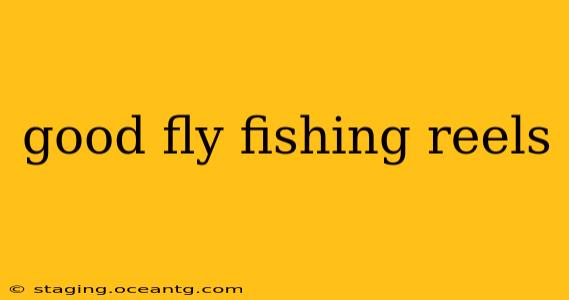Choosing the right fly fishing reel can significantly impact your angling experience. A good reel isn't just about looks; it's about performance, durability, and suitability to your fishing style and the type of water you fish. This guide will help you navigate the world of fly reels, covering everything from essential features to top recommendations for different budgets and fishing situations.
What Makes a Fly Fishing Reel "Good"?
A "good" fly fishing reel depends on individual needs, but several key features consistently define quality:
-
Smooth Drag System: A smooth drag is crucial for controlling powerful fish. A reliable drag prevents line breakage and allows you to play fish effectively without excessive strain on your rod. Look for reels with sealed drag systems to prevent water intrusion and maintain consistent performance.
-
Durable Construction: Fly fishing reels endure tough conditions. High-quality materials like machined aluminum or graphite ensure longevity and resistance to corrosion. The reel's construction should be robust enough to withstand the rigors of regular use.
-
Proper Line Capacity: The reel must hold sufficient backing and fly line for the type of fishing you'll be doing. Overfilling can lead to problems, while underfilling limits your fight time with larger fish. Check the manufacturer's specifications to ensure proper line capacity.
-
Weight and Balance: A reel that's too heavy or light can affect your casting and overall comfort. The reel should balance well with your rod to create a harmonious fishing system.
-
Ease of Use: A well-designed reel is intuitive to use, with easy-to-operate drag adjustments and a smooth retrieve mechanism. Consider the feel of the reel in your hand; a comfortable grip enhances your overall fishing experience.
What are the Different Types of Fly Fishing Reels?
Several reel types cater to different fishing styles and budgets:
-
Disc Drag Reels: These offer smooth, consistent drag performance and are widely considered the best all-around choice.
-
Click-and-Pawl Reels: These classic reels are simpler and often more affordable, featuring a distinct "click" sound during the retrieve. While charming, they generally offer less drag control than disc drag reels.
-
Sealed Drag Reels: Designed for saltwater fishing or wet conditions, these reels prevent water ingress, ensuring consistent drag performance in challenging environments.
-
Large Arbor Reels: These reels feature a large spool diameter, facilitating faster line retrieval, reducing line memory, and improving overall performance.
What Size Fly Fishing Reel Do I Need?
Reel size is directly related to the weight of the fly rod you are using. Manufacturers typically provide sizing recommendations for their reels. Match your reel size to your rod weight for optimal balance and performance. Using a reel that is too large or small will affect your casting ability and control over your fish.
What is the Best Fly Fishing Reel for Beginners?
For beginners, a durable, reliable, and reasonably priced disc drag reel is a great starting point. Many reputable brands offer entry-level reels with excellent features at accessible price points. Focus on a smooth drag system and comfortable ergonomics for a positive initial experience.
What are Some of the Top-Rated Fly Fishing Reels?
Several brands consistently receive high praise for their quality and performance, including but not limited to: Ross Reels, Abel Reels, Hatch Reels, and Lamson Reels. These manufacturers offer a range of reels catering to different budgets and fishing styles. Research individual models within these brands to find the best fit for your needs and preferences. Remember, the "best" reel is subjective and dependent on your fishing style and budget.
How Do I Maintain My Fly Fishing Reel?
Regular maintenance is essential for extending the life of your reel and ensuring smooth operation. Regular cleaning and lubrication are key to preventing corrosion and maintaining a smooth drag system. Always consult your manufacturer's instructions for specific cleaning and maintenance procedures.
What is the Difference Between a Fly Reel and a Spinning Reel?
Fly reels and spinning reels are designed for vastly different fishing techniques. Fly reels are used with fly rods and lines, focusing on delicate presentations and precise casting. Spinning reels are used with spinning rods and lines, employed for a wider range of fishing techniques. They have distinct designs and mechanisms reflecting their specific purposes.
This comprehensive guide offers valuable information to aid in selecting a suitable fly fishing reel. Remember to consider your fishing style, budget, and the type of water you will be fishing to make an informed decision. Happy fishing!
